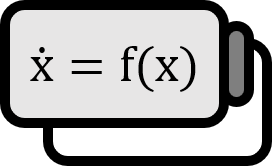Bendixson's Criterion
Bendixson’s Criterion
Given a space $\mathbb{R}^{2}$ and a function $f,g \in C^{1} \left( \mathbb{R}^{2} \right)$, let us consider the following vector field as a differential equation: $$ \dot{x} = f(x,y) \\ \dot{y} = g(x,y) $$ In the simply connected region $D \subset \mathbb{R}^{2}$, if $$ {{ \partial f } \over { \partial x }} + {{ \partial g } \over { \partial y }} \ne 0 $$ the sign does not change, then the given $2$th order vector field does not have a closed orbit inside $D$.
- A simply connected region $D \subset \mathbb{R}^{2}$ means that there are no holes inside the boundary of $D$.
Intuitive Explanation
Mathematically, $f$ and $g$ refer to the vector field itself, and the system’s divergence $\displaystyle {{ \partial f } \over { \partial x }} + {{ \partial g } \over { \partial y }}$ represents how the vector field itself is changing. The change in the vector field itself can be seen geometrically as the region where the flow remains expanding or contracting. If this is not $0$ while its sign does not change, it conceptually means that $D$ is always unstable as it evolves over time.
Proof1
By the chain rule, $$ {{ d y } \over { d x }} = {{ d y } \over { d t }} {{ d t } \over { dx }} = {{ g } \over { f }} $$ Raising $f dx$ at both ends yields $$ fdy = g dx $$ Assuming that a closed orbit $\Gamma$ exists inside $D$ and since $f dy - g dx = 0$, on the surface of $\Gamma$, we have $$ \int_{\Gamma} f dy - g dx = 0 $$
Green’s Theorem: $$ \int_{\mathcal{C}} (Pdx + Qdy) = \iint_{S} (Q_{x} - P_{y}) dx dy $$
According to Green’s theorem, $$ 0 = \int_{\Gamma} f dy - g dx = \iint_{D} \left( {{ \partial f } \over { \partial x }} + {{ \partial g } \over { \partial y }} \right) dx dy $$ However, since it is assumed that the sign of $\displaystyle {{ \partial f } \over { \partial x }} + {{ \partial g } \over { \partial y }} \ne 0$ does not change in the region $D$, $$ \iint_{D} \left( {{ \partial f } \over { \partial x }} + {{ \partial g } \over { \partial y }} \right) dx dy \ne 0 $$ must be the case. This is a contradiction, so a closed orbit $\Gamma$ does not exist inside $D$.
■
Generalization
Dulac’s Criterion
In the simply connected region $D \subset \mathbb{R}^{2}$, let $B (x,y)$ be a smooth function and $$ {{ \partial (Bf) } \over { \partial x }} + {{ \partial (Bg) } \over { \partial y }} \ne 0 $$ if the sign does not change, then the given $2$th order vector field does not have a closed orbit inside $D$.
Wiggins. (2003). Introduction to Applied Nonlinear Dynamical Systems and Chaos Second Edition(2nd Edition): p72. ↩︎
